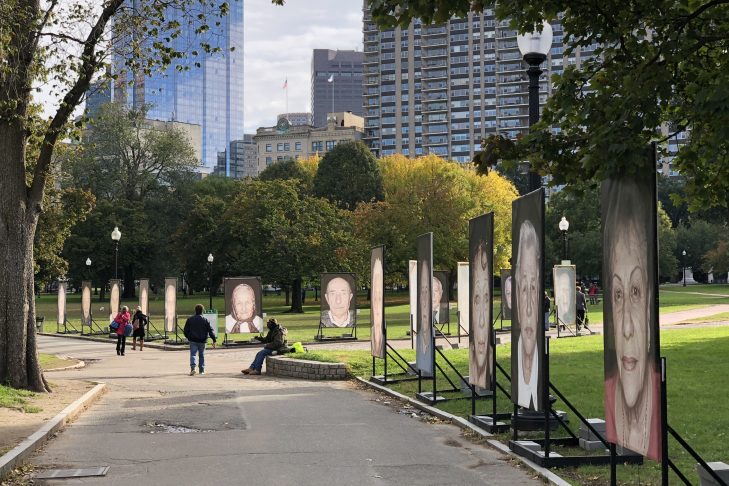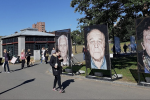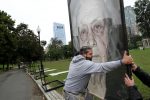Installed on the Boston Common are 70 large-scale, full-color photographs of elderly Holocaust survivors that are so alive they are practically breathing. These close-up headshots of women and men are the work of the German-Italian photographer Luigi Toscano. They are part of his “Lest We Forget” series that is embedded in what he calls “The Remembrance Project.”
Since 2015, Toscano has photographed more than 200 Holocaust survivors in seven countries. He has exhibited his photographs in public places so they are accessible to as many people as possible. The Boston exhibit comes on the heels of shows in Germany, Ukraine, the United Nations in New York City and the Reflecting Pool of the Lincoln Memorial in Washington, D.C.
The photographs’ symbolic staging in the oldest public city park in the United States, and in proximity to famous Boston landmarks, such as the gold-domed State House and the Old South Meeting House, makes these portraits all the more urgent. The photographs of these survivors—nine Boston-area residents are pictured among them—telegraph the horrific consequences of anti-Semitism.
An artist’s statement asserts: “‘Lest We Forget’ is a testament to all survivors of the Holocaust. Each person’s experience was unique, yet those experiences represent all those voices that can no longer be heard. The project is much more than just a look back at our past. Through remembrance, we raise awareness of hatred and bigotry in society today. ‘Lest We Forget’ urges everyone to confront the past in order to ensure that nothing like this ever happens again.”
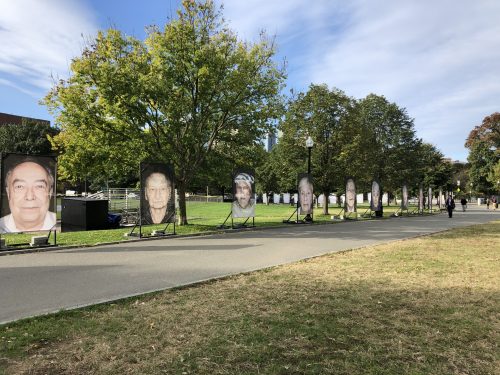
And yet as I write this essay, the morning news brings a report on a rally against anti-Semitism in a Boston suburb. It is a response to drawings of swastikas that were discovered in a high school science laboratory. In its latest annual audit of domestic anti-Semitic incidents, the Anti-Defamation League pointed to a surge of almost 60 percent in anti-Semitism in 2017. Last spring a headline in The Washington Post proclaimed that nearly two-thirds of millennials could not identify what Auschwitz was.
Context matters. On informational panels attached to the sides of the photographs, underneath the survivors’ names are biographical details of what happened to them in the war. Many of them survived Auschwitz. Bostonian Stephan “Steve” Ross was the only survivor among his parents and six siblings. Ross was in six concentration camps before he was liberated at the age of 14 from Dachau.
Joseph Polak, originally from the Netherlands, and the rabbi emeritus of Boston University’s Hillel, survived the Westerbork transit camp and, like Anne Frank, was sent to Bergen-Belsen. Shortly before he was liberated in 1945, he survived a death march to Poland. His father died in the Holocaust, but he was eventually reunited with his mother.
Last week I visited the “Lest We Forget” exhibit. I spent a couple of hours reading each biographical card. As I stared into the eyes of each of the survivors, I remembered something I had recently read about Zen Buddhism’s paradoxical riddles, called “koans.” One of these riddles stayed with me as I walked up and down the rows of faces: “What did your face look like before your parents were born?” Did this question hold the key to my Jewish identity? Before these survivors were born, their families had been in Eastern Europe and beyond for generations. So many faces, so many bloodlines, perished in the Holocaust. What was life like before 1939?
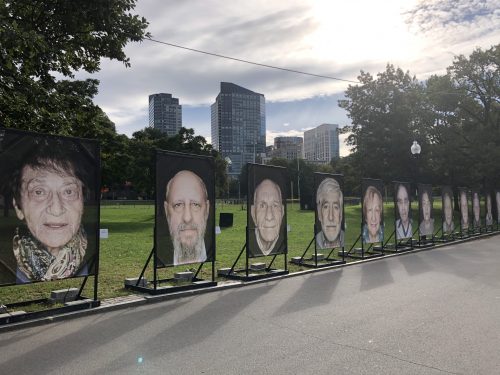
I did not lose family in the Holocaust. But I lost my fellow Jews. They are my people, my tribe. If I had the time, I would do a similar observation experiment called “The Power of Patience.” The experiment is straightforward: Sit in front of a painting or photograph for three hours and record in detail the observations, questions and speculations that occur over that period of time.
“Paintings,” writes the art historian Jennifer L. Roberts, “are time batteries. They are exorbitant stockpiles of temporal experience and information that can only be tapped and unpacked using the skills of slow processing and strategic patience—skills that our impatient world has caused to atrophy.”
These photographs demand patience. They demand attention. They elicit love. These faces are works of art, as well as archives of a history beyond imagination, beyond horror. Lest we forget what they witnessed. Lest we forget what they survived.


